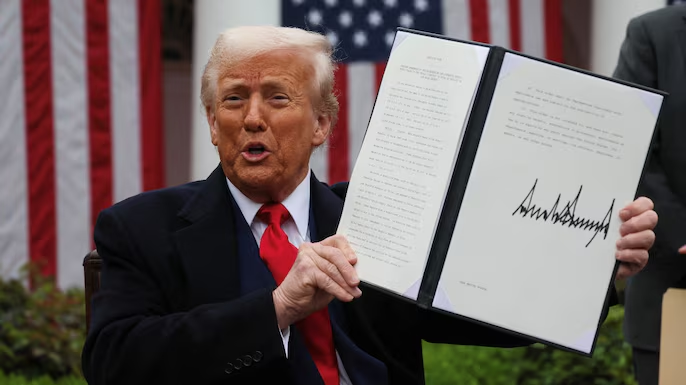New Delhi: On April 2, 2025, US President Donald Trump unveiled a groundbreaking tariff policy, announcing reciprocal tariffs targeting over 180 countries and economies. This bold move, dubbed “Liberation Day” by the President, introduces a 10% baseline tariff on all imports, alongside steeper country-specific duties such as 27% on India, 34% on China, 20% on the European Union (EU), and 24% on Japan. Aimed at reversing trade imbalances and revitalizing American manufacturing, this policy marks a significant shift toward economic nationalism.

What Are Reciprocal Tariffs and Why Now?
Reciprocal tariffs are a trade strategy where a country mirrors the tariff rates imposed on its exports by other nations. In this case, Trump’s administration has set tariffs to counter what it perceives as unfair trade practices and to address the United States’ persistent trade deficit, which exceeded $1.2 trillion in goods in 2024. The baseline 10% tariff applies universally, effective April 5, 2025, at 12:01 AM EDT, while higher reciprocal rates—such as 34% on China and 27% on India—kick in on April 9, 2025, reflecting half the rates those countries allegedly charge on US goods.
The timing aligns with Trump’s “America First” agenda, reenergized in his second term starting January 2025. During his “Liberation Day” speech, Trump emphasized reindustrialization, job creation, and reducing reliance on foreign goods. This policy also serves as retaliation against practices like currency manipulation and high value-added taxes (VAT) imposed by trading partners, which he claims disadvantage American exporters.
Key Objectives of Trump’s Tariff Plan
- Reindustrialization: Boost domestic manufacturing by making imported goods costlier.
- Economic Nationalism: Favor US control over economy, labor, and capital, echoing mercantilist principles.
- Revenue Generation: Potentially replace income taxes with tariff revenue, a point Trump highlighted alongside promises of massive tax cuts.
- Trade Balance: Reduce the trade deficit by penalizing countries with surpluses against the US.
- Foreign Policy Leverage: Use tariffs as a negotiation tool, as seen previously with fentanyl-related tariffs on Canada, Mexico, and China.
How Tariffs Work: A Simple Breakdown
Tariffs are taxes levied on imported goods, paid by US companies to Customs and Border Protection before products enter the market. For instance, a US retailer importing $100,000 worth of Japanese electronics with a 24% tariff would pay $24,000 in duties. This cost often trickles down to businesses and consumers, influencing prices and supply chains.
Trump’s reciprocal tariffs add complexity. The 10% baseline applies to all imports, but exemptions exist for goods like pharmaceuticals, semiconductors, and items under existing Section 232 tariffs (e.g., steel and aluminum). Country-specific rates, like India’s 27%, are calculated based on perceived trade barriers, including tariffs and non-monetary factors like currency manipulation.
Country-Specific Tariffs: Who’s Hit Hardest?
Here’s a snapshot of the major economies facing reciprocal tariffs:
- China: 34% (on top of a 20% existing tariff, totaling 54%)
- India: 27% (revised down from 27% in initial White House documents)
- European Union: 20%
- Japan: 24%
- Vietnam: 46%
- Bangladesh: 37%
- Sri Lanka: 44%
- South Korea: 25%
Canada and Mexico, part of the USMCA trade agreement, dodge the reciprocal hikes but face a 25% tariff on non-USMCA-compliant goods. Trump justified these rates by arguing they reflect fairness, stating, “Treat us like we treat you.”
Impact on Businesses: Winners and Losers
Higher Costs and Supply Chain Shocks
US businesses reliant on imports face immediate challenges. Manufacturers importing components from China or Vietnam, now hit with 54% and 46% tariffs respectively, will see production costs soar. For example, electronics firms sourcing parts from Asia may pass these costs to consumers or absorb them, squeezing profit margins.
The auto industry faces a double blow. Trump announced a 25% tariff on all foreign-made automobiles, effective midnight April 2, 2025, which could raise car prices by thousands. A $30,000 imported vehicle might jump to $37,500, impacting middle-class buyers.
Opportunities for Domestic Producers
On the flip side, US manufacturers could benefit as imported goods become less competitive. Industries like steel, textiles, and machinery might see a resurgence, aligning with Trump’s onshoring vision. However, modern automation means job growth may not match historical industrial booms.
Investment Uncertainty
Companies may delay expansion or R&D as they grapple with unpredictable costs and potential retaliation. Small businesses, less able to absorb tariff hikes, could struggle most, especially in sectors like retail and construction.
Consumer Prices: What to Expect
Will your grocery bill or next car purchase cost more? It depends:
- Price Hikes: Retailers like Walmart or tech giants like Apple might raise prices on imported goods—think sneakers, smartphones, or TVs. Analysts predict a $1,900 annual hit per US household.
- Cost Absorption: Some firms may eat the costs to stay competitive, risking layoffs or reduced growth.
- Market Shifts: Consumers could pivot to US-made alternatives or goods from tariff-exempt nations, though domestic options often carry higher labor costs.
India’s Unique Position: Challenges and Opportunities
India faces a 27% tariff, lower than China’s 54% or Vietnam’s 46%, reflecting its relatively smaller trade surplus with the US ($46 billion in 2024). Here’s how key sectors might fare:
Electronics and Mobile Phones
India’s $6 billion mobile phone export market, boosted by Apple’s local assembly, could stall. High tariffs on components from China and Taiwan may disrupt supply chains, though India could attract new manufacturing if it outcompetes Vietnam.
Gems and Jewellery
Accounting for 13% of India’s US exports, this sector—led by firms like Rajesh Exports and Titan—faces headwinds. A 27% tariff could dent competitiveness, though higher duties on rivals like Bangladesh (37%) offer a chance to gain market share.
Pharmaceuticals
Currently exempt, India’s $10 billion drug export industry (e.g., Lupin, Cipla) dodged a bullet. Any future sectoral tariff could threaten its generic drug dominance in the US.
Textiles and Apparel
With China and Bangladesh facing steeper tariffs, India’s Gokaldas Exports and Arvind could capitalize on a US market shift, enhancing India’s global textile standing.
Indian experts like Ajay Srivastava of the Global Trade Research Initiative argue that gains won’t come automatically—India needs reforms to boost scale and competitiveness.
Global Reactions: Trade War Looms
China Strikes Back
On April 4, 2025, China retaliated with 34% tariffs on all US imports, effective April 10. Beijing also restricted rare-earth mineral exports and targeted US firms, signaling a full-scale trade war. Economists warn this could shave 2.5% off China’s 2025 growth.
EU and Japan Respond
The EU’s Ursula von der Leyen hinted at a measured response, keeping negotiation doors open, while Japan’s PM Shigeru Ishiba called the tariffs a “national crisis,” planning cross-party talks.
Markets in Turmoil
Wall Street’s worst day since 2020 saw the Dow drop 1,600 points on April 3, followed by a 1,000-point slide on April 4 after China’s announcement. Asian and European markets also tanked, with fears of a 2025 recession growing.
Economic Nationalism: A New Era?
Trump’s tariffs embody mercantilism—using trade barriers to boost national power. This shift from hyper-globalization prioritizes domestic control over free markets, echoing post-independence India’s developmentalism but with a protectionist twist. Critics argue it risks inflation and global slowdown, while supporters see it as a bold correction to decades of trade inequity.
What’s Next?
As the 10% baseline tariff takes effect today, April 5, 2025, and reciprocal rates loom on April 9, the world watches. Will Trump’s gamble spark a manufacturing renaissance or a trade war spiral? For businesses, consumers, and nations like India, the coming months will reveal the true cost—and opportunity—of this seismic policy shift.
FAQs
1. What Are Reciprocal Tariffs, and How Do They Work Under Trump’s 2025 Plan?
Answer: Reciprocal tariffs are taxes imposed by a country on imports to mirror the tariffs other nations place on its exports. Under President Trump’s 2025 plan, announced on April 2, the US introduced a 10% baseline tariff on all imported goods starting April 5, 2025, alongside higher country-specific rates—like 27% on India, 34% on China, 20% on the EU, and 24% on Japan—effective April 9, 2025. These tariffs are paid by US companies importing goods, calculated as a percentage of the goods’ value, and aim to balance trade by making foreign products costlier, encouraging domestic production.
2. Why Did Trump Impose These Tariffs, and What Are the Goals?
Answer: Trump’s administration imposed these tariffs to address trade imbalances, combat unfair practices (like high tariffs on US goods abroad), and boost American manufacturing. Announced during his “Liberation Day” speech, the goals include generating federal revenue (potentially replacing income taxes), reindustrializing the US, and leveraging trade negotiations. It’s part of an “America First” economic nationalism push, reacting to decades of globalization that Trump claims hurt US industries and jobs.
3. How Will Trump’s Tariffs Affect Consumer Prices in the US?
Answer: The tariffs could raise prices for US consumers, depending on how businesses respond. For example, a 25% tariff on foreign cars or a 27% tariff on Indian textiles might increase costs for vehicles and clothing, with estimates suggesting an extra $1,900 annually per household. Companies might pass these costs to consumers, absorb them (reducing profits), or shift to domestic or exempt sources. Everyday items like sneakers, electronics, and imported food could see price hikes as early as April 2025.
4. What Impact Will the 27% Tariff Have on India’s Exports to the US?
Answer: India’s 27% tariff, lower than China’s 34% or Vietnam’s 46%, will challenge sectors like electronics (e.g., iPhones), gems and jewellery, and textiles, which make up significant portions of its $18 billion in US exports. However, it’s an opportunity too—higher tariffs on rivals like Bangladesh (37%) could boost India’s textile market share. Pharmaceuticals are currently exempt, but experts warn India must improve competitiveness to offset losses, especially as US demand may shift.
5. How Are Other Countries Responding to Trump’s Tariffs as of April 5, 2025?
Answer: As of today, April 5, 2025, global reactions are intensifying. China retaliated on April 4 with 34% tariffs on all US imports starting April 10, plus rare-earth export bans, escalating the trade war. The EU is exploring a cautious response, while Japan labeled it a “crisis.” Canada, under USMCA, faces selective 25% tariffs but avoids broader reciprocal rates. Markets worldwide, including a 1,600-point Dow drop on April 3, reflect fears of a global economic slowdown.

